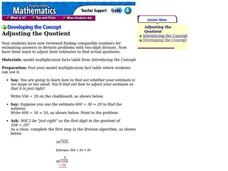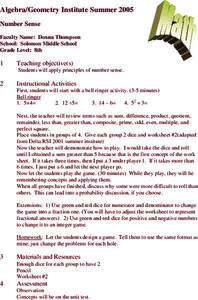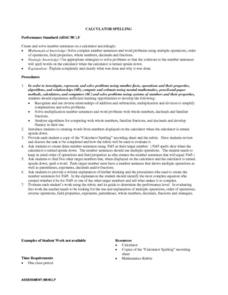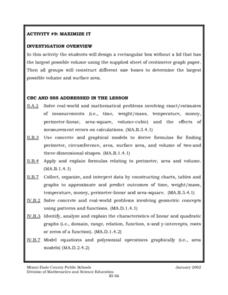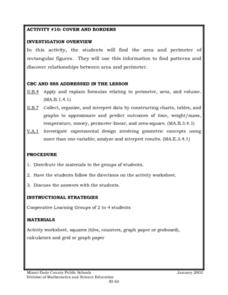Curated OER
Reversals with Multiplication and Division
In this mathematics worksheet, students read the table that shows the answer to the cost per kilogram when 3.678 kg of a product costs $14.89 rounded to the nearest cent. They complete the table and round where necessary for each problem.
Curated OER
Addition and Subtraction, Multiplication and Division
Students must use their mathematical reasoning skills in order to make four math statements true by filling in the boxes with the correct digits. Addition, subtraction, multiplication, and division problems appear.
Curated OER
Addition and Subtraction, Multiplication and Division Review
Students must use their mathematical reasoning skills in order to make four math statements true by filling in the boxes with the correct digits. Addition, subtraction, multiplication, and division problems appear.
Curated OER
Using the Land
In this land instructional activity, students review the different ways that land is used such as landfills, topsoil, farmland, and hazardous waste. This instructional activity has 13 true or false questions and 1 short answer question.
Curated OER
Adjusting the Quotient
Learners solve division problems. In this division lesson, students review estimating and how to figure out if their estimate is too large or too small. Learners solve division problems and use their estimating skills to adjust the...
Curated OER
Pascal's Triangle
Students study Pascal's triangle. They construct their own version of Pascal's triangle, and relate some of the uses for it. While working through this process, students practice their integer multiplication and division skills.
Curated OER
Remainder of One
Fifth graders are introduced to division and remainders. In groups, they are given a set of cubes and read the story a "Remainder of One". While reading the book, they use the cubes to represent the equations mentioned. To end the...
Curated OER
Working With Remainders
For this division worksheet, students solve 48 simple division problems with remainders. Problems are set up as 8 pages of 5 problems each.
Curated OER
Open-Ended; Joining (Addition), Part-Part-Whole
Given a budget, a list of items to put in a treat bag, and how much each item costs might be a little difficult for your students at first. However, these are all going into a treat bag for Madeline's friends. What would your learners...
Curated OER
Order of Operations
In this order of operations worksheet, students simplify and evaluate 10 different types of problems by applying the order of operations in each. They simplify basic equations whether multiplication, division, addition, or subtraction....
Curated OER
Number Sense
Eighth graders participate in a lesson that is concerned with reviewing basic math concepts using the four operations. The activity is composed of a math game that is played by them.
Curated OER
Hands On: Equal Groups
For this equal groups worksheet, students use counters to help them solve the word problems about equal groups. Students use division to find the equal groups from the given numbers.
Curated OER
Calculating Baseball Statistics
Students calculate baseball statistics. In this data analysis lesson, students use baseball statistics to calculate the batting average and slugging percentage. Students visit www.funbrain.com to play a math baseball game.
Curated OER
Calculator Spelling
Sixth graders practice creating and solving number sentences on a calculator. They interact with number facts, their properties, algorithms and estimation. Each student recognizes inverse relationships of addition, subtraction,...
Curated OER
Count on Me
Fourth graders use inductive reasoning to find algebraic patterns in geometric figures. They use technology (i.e., calculators, computers) and manipulatives to discover number patterns involving geometric concepts. They solve concrete...
Curated OER
Positive and Negative Numbers
Pupils use blocks and markers to illustrate the processes of adding, subtracting, multiplying and dividing integers. In this mathematics lesson, learners use Algebra blocks to demonstrate multiplying polynomials.
Illustrative Mathematics
Zeroes and factorization of a quadratic polynomial I
This activity uses the division algorithm and the definition of a zero/root of a function to guide your class to see the relationship between zeros and factors of a general quadratic, which can later be generalized to the Remainder...
Illustrative Mathematics
Zeroes and Factorization of a General Polynomial
These four problems will guide your class through the idea behind the Fundamental Theorem of Algebra, which states that a polynomial of degree n has exactly n roots. Use the division algorithm and the definition of a zero/root of a...
Curated OER
Maximize It!
Students design a rectangular box without a lid that has the largest possible volume using the supplied sheet of centimeter graph paper. They work in groups to construct different size boxes to determine the largest possible volume and...
Curated OER
Discovering Math: Computation
Middle schoolers add, subtract, multiply, and divide rational numbers. They find the square and the cube of numbers. They create a game incorporating computation on rational numbers. Everyone works together to write and evaluate...
Curated OER
Story Map for Bud, Not Buddy
Why should your class complete a story map? After reading Bud, Not Buddy, divide your class into pairs or small groups to complete the included worksheet. They list the main characters, the conflict, main plot events, the resolution, and...
Curated OER
The Right Stuff
Studentsare introduced to the Pythagorean Theorem by exploring right triangles and the squares built on each side. They apply the Pythagorean Theorem to real-world problems. Students u se informal and nonformal arguments of proof (i.e.,...
Teacher Created Resources
PEMDAS: Order of Operations
Learners complete algebraic equations. They learn the algebraic order of operations and the acronym, PEMDAS, to help them remember the correct order of operations. Pupils complete algebraic equations using the order of operations.
Curated OER
Cover and Boarders
Students find the area and perimeter of rectangular figures. They use this information to find patterns and discover relationships between area and perimeter. Students apply and explain formulas relating to perimeter, area, and volume.






